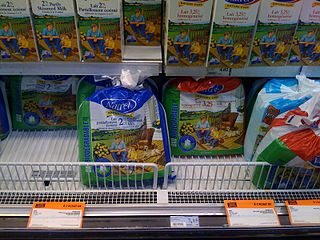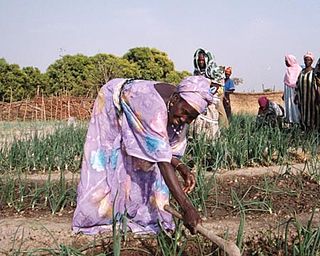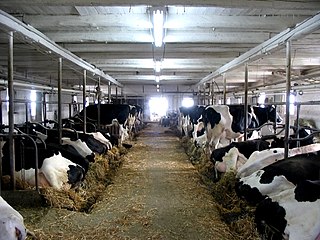
The Agricultural Marketing Act of 1929, under the administration of Herbert Hoover, established the Federal Farm Board from the Federal Farm Loan Board established by the Federal Farm Loan Act of 1916 with a revolving fund of half a billion dollars. The original act was sponsored by Hoover in an attempt to stop the downward spiral of crop prices by seeking to buy, sell and store agricultural surpluses or by generously lending money to farm organizations. Money was lent out to the farmers in order to buy seed and food for the livestock, which was especially important since there had previously been a drought in the Democratic South. However, Hoover refused to lend to the farmers themselves, as he thought that it would be unconstitutional to do so and if they were lent money, they would become dependent on government money.

The Agricultural Adjustment Act (AAA) was a United States federal law of the New Deal era designed to boost agricultural prices by reducing surpluses. The government bought livestock for slaughter and paid farmers subsidies not to plant on part of their land. The money for these subsidies was generated through an exclusive tax on companies which processed farm products. The Act created a new agency, the Agricultural Adjustment Administration, also called "AAA" (1933-1942), an agency of the U.S. Department of Agriculture, to oversee the distribution of the subsidies. The Agriculture Marketing Act, which established the Federal Farm Board in 1929, was seen as an important precursor to this act. The AAA, along with other New Deal programs, represented the federal government's first substantial effort to address economic welfare in the United States.

Community-supported agriculture or cropsharing is a system that connects producers and consumers within the food system closer by allowing the consumer to subscribe to the harvest of a certain farm or group of farms. It is an alternative socioeconomic model of agriculture and food distribution that allows the producer and consumer to share the risks of farming. The model is a subcategory of civic agriculture that has an overarching goal of strengthening a sense of community through local markets.

The Canadian Dairy Commission is an Ottawa-based Government of Canada Crown Corporation that plays a role of administrator, facilitator and stakeholder in the public policy related to the Canadian dairy industry. The CDC's mandate is to coordinate dairy policies in a jurisdiction that is shared between both provincial and federal governments. In the early 1970s, when the dairy industry became the first industry in Canada to be operated under the national supply management system, the CDC was named as facilitator and administrator coordinating dairy policies and providing a framework for the management of the Canadian dairy industry.

The Richard B. Russell National School Lunch Act is a 1946 United States federal law that created the National School Lunch Program (NSLP) to provide low-cost or free school lunch meals to qualified students through subsidies to schools. The program was established as a way to prop up food prices by absorbing farm surpluses, while at the same time providing food to school age children. It was named after Richard Russell, Jr., signed into law by President Harry S. Truman in 1946, and entered the federal government into schools' dietary programs on June 4, 1946.

An agricultural cooperative, also known as a farmers' co-op, is a cooperative in which farmers pool their resources in certain areas of activity.

The Federal Agriculture Improvement and Reform Act of 1996, known informally as the Freedom to Farm Act, the FAIR Act, or the 1996 U.S. Farm Bill, was the omnibus 1996 farm bill that, among other provisions, revises and simplifies direct payment programs for crops and eliminates milk price supports through direct government purchases.
The Federal Farm Board was established by the Agricultural Marketing Act of 1929 from the Federal Farm Loan Board established by the Federal Farm Loan Act of 1916, with a revolving fund of half a billion dollars to stabilize prices and to promote the sale of agricultural products. The board would help farmers stabilize prices by buying and holding surplus grain and cotton in storage. The Farm Board was part of Herbert Hoover's response to the downward spiral of crop prices in the years leading up to the Great Depression.
The agricultural policy of the United States is composed primarily of the periodically renewed federal U.S. farm bills. The Farm Bills have a rich history which initially sought to provide income and price support to US farmers and prevent them from adverse global as well as local supply and demand shocks. This implied an elaborate subsidy program which supports domestic production by either direct payments or through price support measures. The former incentivizes farmers to grow certain crops which are eligible for such payments through environmentally conscientious practices of farming. The latter protects farmers from vagaries of price fluctuations by ensuring a minimum price and fulfilling their shortfalls in revenue upon a fall in price. Lately, there are other measures through which the government encourages crop insurance and pays part of the premium for such insurance against various unanticipated outcomes in agriculture.

The consumption and production of marketed food are spatially separated. Production is primarily in rural areas while consumption is mainly in urban areas. Agricultural marketing is the process that overcomes this separation, allowing produce to be moved from an area of surplus to one of need. Food reaches the consumer by a complex network, involving production, assembly, sorting, packing, reassembly, distribution and retail stages. In developing countries the linkage between the producer and the retailer is still usually provided by assembly and wholesale markets, where wholesale marketing takes place using a variety of transaction methods. Recent years have seen an expansion of wholesale marketing in European and former CIS countries. On the other hand, the growth of supermarkets in many regions has seen the development of direct marketing and a reduced role for wholesale systems.
Classified pricing is the pricing system of federal milk marketing orders, under which milk processors pay into a pool for fluid grade milk. The price that processors have to pay into the pool is based on how the milk ultimately is used. Milk used for fluid (Class I) consumption generally receives the highest price and lower minimum prices are paid for the three classes of milk used for manufactured dairy products: Class II, Class III (cheese), and Class IV.
In the United States, the Dairy Price Support Program is the federal government program that maintains a minimum farm price for milk used in the manufacture of dairy products. It is one of many agricultural support programs. Under the dairy program, the United States Department of Agriculture (USDA) indirectly assures a minimum price for milk by purchasing any cheddar cheese, nonfat dry milk, and butter offered to it by dairy processors at stated prices. These purchase prices are set high enough to enable dairy processors to pay farmers at least the support price for the milk they use in manufacturing these products.
In United States agricultural policy, utilization rates refer to the percentage of milk in federal milk marketing orders that is used in each of the classes: Class IV, Class III (cheese), Class II, Class I. Utilization rates serve as weights for determining the weighted average price, or blend price, received by dairy farmers within a region each month.
The Southern Dairy Compact was an agreement between thirteen states in the southern United States. It was proposed to ensure the continued marketability of dairy producers in the member states and to supply a stable, local supply of milk products to the region. The proposed agreement was modeled on the Northeast Interstate Dairy Compact, that would allow member states to jointly establish a minimum farm price for fluid milk that is above the federally mandated minimum price level in the region.

The Northeast Interstate Dairy Compact was an agreement among the six New England states to support the farm price of milk at a higher level than under federally mandated minimum prices in the region.
Milk Income Loss Contract (MILC) Payments is the name given by USDA to the dairy farmer counter-cyclical payments program, authorized by the 2002 farm bill. Under the program, dairy farmers nationwide are eligible for a federal payment whenever the minimum monthly market price for farm milk used for fluid consumption in Boston falls below $16.94/cwt. A producer potentially can receive a payment equal to 45 percent of the difference between the $16.94 per cwt. target price and the market price, in any month that the Boston market price falls below $16.94. A producer can receive a payment on all milk production during that month, but no payments will be made on any annual production in excess of 2.4 million pounds per dairy operation. On average this limit is reached by a milking herd of 130 cows. MILC payments apply to production beginning December 1, 2002 through September 30, 2012.
Marketing orders and agreements in United States agricultural policy allow producers to promote orderly marketing through collectively influencing the supply, demand, or price of a particular commodity. Research and promotion can be financed with pooled funds.
In United States federal milk marketing orders, the fluid differential is the amount added to the base price of milk to determine a region’s minimum price for milk used for fluid (drinking) purposes.

Dairy farming is one of the largest agricultural sectors in Canada. Dairy has a significant presence in all of the provinces and is one of the top two agricultural commodities in seven out of ten provinces.

Canada's supply management, abbreviated SM, is a national agricultural policy framework used across the country, which controls the supply of dairy, poultry and eggs through production and import controls and pricing mechanisms. The supply management system was authorized by the 1972 Farm Products Agencies Act, which established the two national agencies that oversee the system. The Agriculture and Agri-Food Canada federal department is responsible for both the Canadian Dairy Commission and its analogue for eggs, chicken and turkey products, the Farm Products Council of Canada. Five national supply management organizations, the SM-5 Organizations — Egg Farmers of Canada (EFC), Turkey Farmers of Canada (TFC), Chicken Farmers of Canada (CFC), the Canadian Hatching Egg Producers (CHEP) and the Ottawa-based Canadian Dairy Commission (CDC), a Crown corporation — in collaboration with provincial and national governing agencies, organizations and committees, administer the supply management system.







